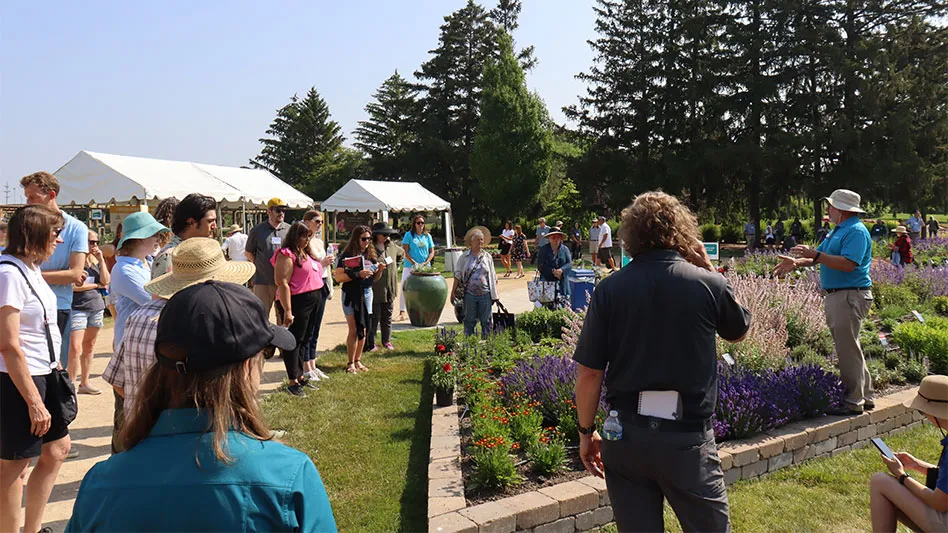 Mary Hausbeck Mary Hausbeck |
Some water mold organisms are well adapted to move via water by swimming spores (zoospores). Movement of Phytophthora spp. via irrigation water has been documented and above ground water sources may play a role in the long-distance movement of some Phytophthora spp. Runoff water from infested fields and nurseries can transport Phytophthora spp. from diseased plants to nearby water sources used for irrigation.
Drip irrigation from well water or ponds fed by well water is recommended to reduce the risk of Phytophthora spread on susceptible crops. Irrigate conservatively and try to limit irrigation whenever possible.
Spores and algaecides
The increasingly common greenhouse practices of recycling irrigation water and nutrient solutions are economically and environmentally beneficial, but also increase the chance to spread waterborne pathogens including Phytophthora spp. There are several methods available for disinfesting contaminated irrigation water, including the use of antimicrobial compounds such as copper.
Commercial algaecides contain copper sulfate, chelated copper or sodium carbonate peroxyhydrate (SCP) as the active ingredient. Copper is suppressive to Phytophthora spp. and spray tank-mixing copper with other fungicides has been shown to improve management of P. capsici in the field.
Recent laboratory studies have shown copper-based algaecides have the potential for treating P. ramorum in water.
Sodium carbonate peroxyhydrate-based algaecides were developed as a non-persistent alternative to copper algaecides, which may build up in aquatic systems and can be toxic to non-target organisms. Upon dissolution in water, sodium carbonate peroxyhydrate releases hydrogen peroxide, a compound that is active against a wide variety of organisms.
Chlorination and algaecide treatments are already used by some growers to control undesirable algal growth in irrigation systems. Algae can serve as a substrate for undesirable bacterial growth and may clog intake screens and filters and other irrigation system components.
Zoospore control
A study was conducted at Michigan State University to examine the effects of copper and sodium carbonate peroxyhydrate-based algaecides on zoospores (Table 1). All of the algaecides tested caused zoospore swimming to cease within three minutes of treatment. The corresponding untreated control zoospores were motile for 4½ to 6 hours.
 CLICK IMAGE TO ENLARGE CLICK IMAGE TO ENLARGE
Algaecide treatments caused significant death of zoospores in water. A contact time of 30 minutes or more resulted in greater zoospore mortality than a contact time of five or 10 minutes. Overall, statistically similar zoospore mortality was observed after treatment for 30, 60, or 120 minutes.
Several of the copper-based and one of the sodium carbonate peroxyhydrate-based algaecides showed efficacy similar to bleach, the positive control, in killing zoospores when the contact time was 30 minutes or more. All treatments were better than the negative control.
There was no significant interaction between the algaecide treatment and contact time. The water was more alkaline following treatment with eight of 11 of the algaecides tested and bleach.
Further work is needed to determine the efficacy of algaecides in greenhouse, nursery and field settings and to explore potential problems with using algaecide-treated water for irrigation. These problems can include plant phytotoxicity and effects on non-target species.
Copper considerations
The effectiveness of copper-based algaecides is affected by the concentration and form of copper applied, the duration of exposure and characteristics of the water body. Elevated copper concentrations were observed for several weeks following algaecide treatment of a reservoir.
The persistence and concentration of copper in water and sediments significantly affects the impact on non-target species including phytoplankton and fish. This persistence should be considered if algaecides are applied to a water source to reduce Phytophthora zoospores.
Excess copper in irrigation water may lead to phytotoxicity including reduced plant growth and photosynthetic ability. Sodium carbonate peroxyhydrate has been less well studied than copper, but it is known that efficacy is affected by the soluble organic matter content in the water. Hydrogen peroxide may be phytotoxic, especially to young plants, when used at rates required to control algae.
This article was co-written by Leah Granke, research associate, Michigan State University, Department of Plant Pathology. The research was funded by the Floriculture and Nursery Research Initiative under Cooperative Agreement #59-1907-5-553 with the USDA-Agricultural Research Service and the American Floral Endowment.
Mary Hausbeck is professor at Michigan State University, Department of Plant Pathology, www.plantpathology.msu.edu.
|
 Mary Hausbeck
Mary Hausbeck






